Popular categories
Looking for a yarn?

100% Wool
from 3.75 € /50g
Order DROPS Needles & Hooks
Clicking the ORDER button will redirect you to Mallia Kouvaria - pleko.gr. website
The yarn cost is calculated from the pattern’s smallest size and the yarn’s cheapest product type. Looking for an even better price? You might find it on the DROPS Deals!
Dripping Diamonds
Knitted jumper with raglan in DROPS Big Merino. Piece is knitted top down with lace pattern. Size: S - XXXL
DROPS design: Pattern mb-059
Yarn group C or A + A
----------------------------------------------------------
SIZE:
S - M - L - XL - XXL - XXXL
MATERIALS:
DROPS BIG MERINO from Garnstudio (belongs to yarn group C)
600-600-700-750-800-900 g colour 01, off white
KNITTING TENSION:
17 stitches in width and 22 rows vertically in stocking stitch = 10 x 10 cm.
NEEDLES:
DROPS DOUBLE POINTED NEEDLES SIZE 5 mm
DROPS CIRCULAR NEEDLE SIZE 5 mm : Length 40 cm, 60 cm and 80 cm for stocking stitch.
DROPS DOUBLE POINTED NEEDLES SIZE 4.5 mm
DROPS CIRCULAR NEEDLE SIZE 4.5 mm : Length 40 and 80 cm for edges in garter stitch
Needle size is only a suggestion! If you have too many stitches on 10 cm switch to a larger needle size. If you have too few stitches on 10 cm switch to a smaller needle size.
-------------------------------------------------------
Alternative Yarn – See how to change yarns here
Yarn Groups A to F – Use the same pattern and change the yarn here
Yarn usage using an alternative yarn – Use our yarn converter here
-------------------------------------------------------

100% Wool
from 3.75 € /50g
Order DROPS Needles & Hooks
Clicking the ORDER button will redirect you to Mallia Kouvaria - pleko.gr. website
The yarn cost is calculated from the pattern’s smallest size and the yarn’s cheapest product type. Looking for an even better price? You might find it on the DROPS Deals!
- English (UK/cm), Greece
- Česky
- Dansk
- Deutsch
- Eesti keel
- English (UK/cm)
- English (US/in)
- Español
- Français
- Íslenska
- Italiano
- Magyar
- Nederlands
- Norsk
- Polski
- Português
- Suomi
- Svenska
- English (UK/cm), Bulgaria
- English (UK/cm), Croatia
- English (UK/cm), Latvia
- English (UK/cm), Lithuania
- English (UK/cm), Romania
- English (UK/cm), Slovenia
- Česky, Slovakia
Pattern instructions
EXPLANATION FOR THE PATTERN:
----------------------------------------------------------
GARTER STITCH (worked in the round):
1 ridge = 2 rounds. Knit 1 round and purl 1 round.
PATTERN:
See diagrams A.1 to A.4. Diagrams show all rows in pattern seen from the right side.
INCREASE TIP-1 (evenly):
To calculate how to increase evenly, use the total number of stitches on row (e.g. 78 stitches) and divide stitches by number of increases to be done (e.g. 8) = 9.75.
In this example increase by making 1 yarn over after approx. every 10th stitch. On next round knit yarn overs twisted to avoid holes.
INCREASE TIP-2 (applies to sides of body):
All increases are done from the right side.
Work until 2 stitches remain before marker thread, 1 yarn over, knit 4 (marker thread is in the middle of these stitches), 1 yarn over. On next round knit yarn overs twisted to avoid holes. Then work the new stitches in stocking stitch.
DECREASE TIP (applies to sleeves):
Decrease 1 stitch on each side of marker thread as follows: Work until 3 stitches remain before marker thread and knit 2 together, knit 2 (marker thread is between these stitches), slip 1 stitch knitwise, knit 1, pass slipped stitch over stitch worked.
----------------------------------------------------------
START THE PIECE HERE:
----------------------------------------------------------
JUMPER - SHORT OVERVIEW OF THE PIECE:
Neck edge, yoke and body are worked in the round on circular needle. Begin round in transition between left shoulder and back piece. Work sleeves in the round on double pointed needles/a short circular needle, top down.
NECK EDGE:
Cast on 80-80-80-88-88-88 stitches on circular needle size 4.5 mm with Big Merino. Knit 1 round, then work rib knit 2/purl 2. When piece measures 3 cm, work 1 ridge in GARTER STITCH over all stitches – read explanation above. Knit 1 round while increasing 6-6-6-18-18-18 stitches evenly - read INCREASE TIP-1 = 86-86-86-106-106-106 stitches. Switch to circular needle size 5 mm.
YOKE:
Work as follows: A.1 A (= 5 stitches), A.1 B over the next 20-20-20-30-30-30 stitches ( = 2-2-2-3-3-3 repetitions of 10 stitches), A.1 C (= 6 stitches), 2 stitches in stocking stitch (= raglan line), make 1 yarn over, 8 stitches in stocking stitch (= sleeve), make 1 yarn over, 2 stitches in stocking stitch (= raglan line), A.1 A, A.1 B over the next 20-20-20-30-30-30 stitches, A.1 C, 2 stitches in stocking stitch (= raglan line), make 1 yarn over, 8 stitches in stocking stitch (= sleeve), make 1 yarn over, 2 stitches in stocking stitch (= raglan line) = 8 stitches increased. There are now 94-94-94-114-114-114 stitches on needle.
Continue pattern like this. On front and back piece increase in each side as shown in A.1, on sleeves increase with yarn overs on each side of stitches on sleeve (raglan line = always 2 stitches). Increase like this every other round. On next round knit the yarn overs to make holes. Work the increased stitches in stocking stitch on the sleeves. On front and back piece work the increased stitches in pattern as shown in A.1. REMEMBER THE KNITTING TENSION!
When A.1 has been worked 1 time vertically, there are 166-166-166-186-186-186 stitches on needle. Continue pattern the same way upwards, i.e. pattern is repeated as shown in A.1. Every time 20 row have been vertically, there is room for 2 repetitions more of A.1B in width on back piece/front piece.
When increase has been done 22-22-27-27-27-32 times in total on each side of A.1, there are 262-262-302-322-322-362 stitches on row, and piece measures approx. 24-24-28-28-28-33 cm from neck edge.
Work next round as follows: Work 75-75-85-95-95-105 stitches as before (= back piece), slip the next 56-56-66-66-66-76 stitches on 1 stitch holder for sleeve, cast on 6-8-8-8-12-14 new stitches on needle (= in the side under sleeve), work the next 75-75-85-95-95-105 stitches as before (= front piece), slip the next 56-56-66-66-66-76 stitches on 1 stitch holder for sleeve, cast on 6-8-8-8-12-14 new stitches on needle (in the side under sleeve). Finish body and sleeves separately. NOW MEASURE THE PIECE FROM HERE!
BODY:
= 162-166-186-206-214-238 stitches. Insert 1 marker thread in each side, in the middle of the 6-8-8-8-12-14 stitches that were cast on under each sleeve. Move the marker threads upwards when working; they should be used for increase later.
Work first round as follows, begin 3-4-4-4-6-7 stitches after marker thread (begin on round marked with arrow in each diagram): A.2 (= 7 stitches), work A.3 over the next 60-60-70-80-80-90 stitches (= 6-6-7-8-8-9 repetitions of 10 stitches), A.4 (= 8 stitches), work 6-8-8-8-12-14 stitches in stocking stitch (marker thread is in the middle of these 6-8-8-8-12-14 stitches), A.2 (= 7 stitches), work A.3 over the next 60-60-70-80-80-90 stitches (= 6-6-7-8-8-9 repetition of 10 stitches), A.4 (= 8 stitches), work 6-8-8-8-12-14 stitches in stocking stitch (marker thread is in the middle of these 6-8-8-8-12-14 stitches),
Continue pattern like this, repeat A.2, A.3 and A.4 vertically. When piece measures 5 cm from division, increase 1 stitch on each side of both marker threads - read INCREASE TIP-2 = 4 stitches increased. Increase like this every 7 cm 4 times in total = 178-182-202-222-230-254 stitches. Work until piece measures approx. 29-31-29-31-33-31 cm from division. Switch to circular needle size 4.5 mm. Work 2 ridges. Switch back to circular needle size 5 mm. Cast off. Jumper measures approx. 58-60-62-64-66-68 cm from shoulder and down.
SLEEVE:
Slip the 56-56-66-66-66-76 stitches from stitch holder in one side of piece on a short circular needle/double pointed needles size 5 mm and pick in addition up 1 stitch in each of the 6-8-8-8-12-14 stitches cast on under sleeve = 62-64-74-74-78-90 stitches. Insert 1 marker thread in the middle of the 6-8-8-8-12-14 stitches under sleeve - move the marker thread upwards when working, it is used for decrease later. Begin round at the marker thread and work stocking stitch in the round. When piece measures 3 cm from division, decrease 2 stitches mid under sleeve - read DECREASE TIP. Decrease like this every 2½-2½-2-1½-1½-1 cm 12-12-16-16-17-22 times in total = 38-40-42-42-44-46 stitches. Continue until piece measures approx. 32-33-30-28-29-26 cm from division (shorter measurements in larger sizes because of longer yoke). Switch to double pointed needles size 4.5 mm. Knit 1 round while adjusting number of stitches to 40-40-44-44-44-48. Purl 1 round. Work rib in the round with knit 2/purl 2 for 4 cm. Cast off by knitting but make sure that the cast-off edge is not too tight. Sleeve measures approx. 36-37-34-32-33-30 cm from division. Work the other sleeve the same way.
This pattern has been corrected. Click here to see the correction/s.
NECK EDGE:
Cast on 80-80-80-88-88-88 stitches on circular needle size 4.5 mm with Big Merino. Knit 1 round, then work rib knit 2/purl 2. When piece measures 3 cm, work 1 ridge in GARTER STITCH over all stitches – read explanation above. Knit 1 round while increasing 6-6-6-18-18-18 stitches evenly...
Diagram

|
= knit from the right side, purl from the wrong side |

|
= purl from the right side, knit from the wrong side |

|
= between 2 stitches make 1 yarn over |

|
= knit 2 together |

|
= slip 1 stitch knitwise, knit 1, pass slipped stitch over stitch worked |

|
= slip 1 stitch knitwise, knit 2 stitches together, pass slipped stitch over stitches worked together |

|
= shows 1 repetition vertically and how to place lace pattern on top of each other |

|
= this square is not a stitch, go directly to next symbol in diagram |

|
= begin body on this round |
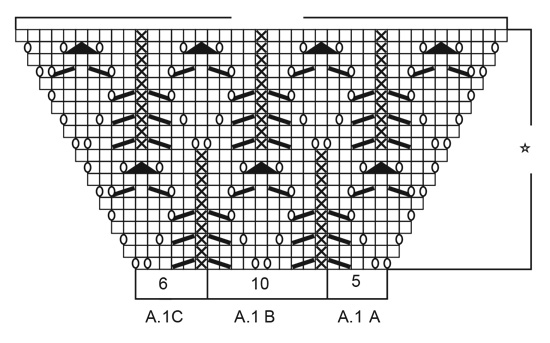
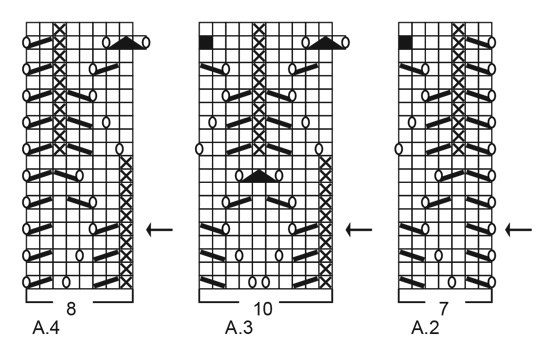

What can you do with our patterns? You can share DROPS patterns online, using the pattern original picture, materials, name and number. But you are NOT ALLOWED to reproduce the complete pattern digitally in any way. Yarn stores are welcome to use the DROPS pattern database to promote the sale of our assortment. You can print out our patterns, make as many copies as you’d like. The only thing we ask is that you don't make any changes / additions to the original printed document. And that the patterns according to the DROPS philosophy are given out to the consumers for free. Editorials that wish to publish our patterns in printed books or magazines can contact us for more information. The sale of garments based on DROPS patterns is permitted as long as they are sold as single items or per order. Further commercial use of the patterns is not permitted. It has to be clearly stated that the garment is made based on a design from DROPS DESIGN. The use of clothing labels of which DROPS DESIGN forms part is conditioned by the inclusion of the following text: “A DROPS DESIGN made by …..”. The use of DROPS photos for marketing purposes/sales is only permitted in connection with the use/sale of DROPS products. The photos may not be cut or edited and the logo should be clearly visible.
We reserve the right to withdraw the permission for use of our patterns at any time, notwithstanding the reason.
Each of our patterns has specific tutorial videos to help you.
These step-by-step tutorials might also help you:
Why is the knitting/crochet tension so important?
Knitting tension is what determines the final measurements of your work, and is usually measured per 10 x 10 cm. It is provided like so: number of stitches in width x number of rows in height - eg: 19 stitches x 26 rows = 10 x 10 cm.
The knitting tension is very individual; some people knit/crochet loosely while others work tightly. You adjust the knitting tension with the needle size, which is why the suggested needle size is only meant as a guide! You need to adjust this (up or down) to ensure that YOUR knitting tension matches the knitting tension provided in the pattern. If you work with a different knitting tension than provided you will have a different yarn consumption, and your work will have different measurements than what the pattern suggests.
The knitting tension also determines which yarns can replace each other. As long as you achieve the same knitting tension you can replace one yarn with another.
See DROPS lesson: How to measure your tension/gauge
See DROPS video: How to make a gauge tension swatch
How do I know how many balls of yarn I need?
The required amount of yarn is provided in grams, eg: 450 g. To calculate how many balls you’ll need you first need to know how many grams are in 1 ball (25g, 50g or 100g). This information is available if you click on the individual yarn quality on our pages. Divide the amount required with the amount of each ball. For example, if each ball is 50g (the most common amount), the calculation will be as follows: 450 / 50 = 9 balls.
Can I use a different yarn than what the pattern suggests?
The important thing when changing from one yarn to another is that the knitting/crochet tension remains the same. This is so that the measurements of the finished piece will be the same as on the sketch provided. It is easier to achieve the same knitting tension using yarns from the same yarn group. It is also possible to work with multiple strands of a thinner yarn to achieve the knitting tension of a thicker one. Please try our yarn converter. We recommend you to always work a test swatch.
Please NOTE: when changing yarn the garment might have a different look and feel to the garment in the photo, due to individual properties and qualities of each yarn.
See DROPS lesson: Can I use a different yarn than the one mentioned in the pattern?
What are the yarn groups?
All our yarns are categorised into yarn groups (from A to F) according to thickness and knitting tension – group A contains the thinnest yarns and group F the thickest. This makes it easier for you to find alternative yarns to our patterns, should you wish to switch yarn. All yarns within the same group have a similar knitting tension and can easily replace each other. However, different yarn qualities have different structures and properties which will give the finished work a unique look and feel.
How do I use the yarn calculator?
At the top of all our patterns you’ll find a link to our yarn calculator, which is a helpful tool should you wish to use a different yarn than suggested. By filling in the yarn quality you wish to replace, the amount (in your size) and number of strands, the calculator will present good alternative yarns with the same knitting tension. Additionally it will tell you how much you’ll require in the new qualities and whether you’ll need to work with multiple strands. Most skeins are 50g (some are 25g or 100g).
If the pattern is worked with multiple colours, every colour will have to be calculated separately. Similarly, if the pattern is worked with several strands of different yarns (for example 1 strand Alpaca and 1 strand Kid-Silk) you will have to find alternatives for each, individually.
Why do you show discontinued yarns in the patterns?
Since different yarns have different qualities and textures we have chosen to keep the original yarn in our patterns. However, you can easily find options among our available qualities by using our yarn calculator, or simply pick a yarn from the same yarn group.
It is possible that some retailers still have discontinued yarns in stock, or that someone has a few skeins at home that they would like to find patterns for.
The yarn calculator will provide both alternative yarn as well as required amount in the new quality.
What size should I knit?
If you think it's hard to decide what size to make, it can be a good idea to measure a garment you own already and like the size of. Then you can pick the size by comparing those measures with the ones available in the pattern's size chart.
You'll find the size chart at the bottom of the pattern.
See DROPS lesson: How to read size chart
Why do I get the wrong knitting tension with the suggested needle size?
The needle size provided in the pattern serves only as a guide, the important thing is to follow the knitting tension. And since knitting tension is very individual, you will have to adjust the needle size to ensure that YOUR tension is the same as in the pattern – maybe you’ll have to adjust 1, or even 2 needle sizes, up or down to achieve the correct tension. For this, we recommend that you work test swatches.
Should you work with a different knitting tension than the one provided, the measurements of the finished garment might deviate from the measurement sketch.
See DROPS lesson: How to measure your tension/gauge
See DROPS video: How to make a tension/gauge swatch
Why is the pattern worked top-down?
Working a garment top-down provides more flexibility and room for personal adjustment. For example it is easier to try the garment on while working, as well as making adjustments to length of yoke and shoulder caps.
The instructions are carefully explaining every step, in the correct order. Diagrams are adjusted to the knitting direction and are worked as usual.
How do I work according to a knitting diagram?
The diagram depicts all rows/rounds, and every stitch seen from the right side. It is read from bottom to top, from right to left. 1 square = 1 stitch.
When working back and forth, every other row is worked from the right side and every other row is worked from the wrong side. When working from the wrong side, the diagram will have to be worked reversed: from left to right, knit stitches are purled, purl stitches are knit etc.
When working in the round every round is worked from the right side and the diagram are worked from right to left on all rounds.
See DROPS lesson: How to read knitting diagrams
How do I work according to a crochet diagram?
The diagram depicts all rows/rounds, and every stitch seen from the right side. It is worked from bottom to top, from right to left.
When working back and forth every other row is worked from the right side: from right to left and every other row is worked from the wrong side: from left to right.
When working in the round, every row in the diagram are worked from the right side, from right to left.
When working a circular diagram you start in the middle and work your way outwards, counter clockwise, row by row.
The rows usually start with a given number of chain stitches (equivalent to the height of the following stitch), this will either be depicted in the diagram or explained in the pattern.
See DROPS lesson: How to read crochet diagrams
How do I work several diagrams simultaneously on the same row/round?
Instructions for working several diagrams after each other on the same row/round, will often be written like so: “work A.1, A.2, A.3 a total of 0-0-2-3-4 times". This means you work A.1 once, then A.2 is worked once, and A.3 is repeated (in width) the number of times provided for your size – in this case like so: S = 0 times, M = 0 times, L=2 times, XL= 3 times and XXL = 4 times.
The diagrams are worked as usual: begin with the first row in A.1, then work the first row in A.2 etc.
See DROPS lesson: How to read knitting diagrams
See DROPS lesson: How to read crochet diagrams
Why are the sleeves shorter in larger sizes?
The total width of the garment (from wrist-to-wrist) will be larger in the larger sizes, despite the actual sleeves being shorter. The larger sizes have longer sleeve caps and wider shoulders, so there will be a good fit in all sizes.
Where on the garment is the length measured?
The measurement sketch/schematic drawing provides information regarding the full length of the garment. If it’s a jumper or a jacket the length is measured from the highest point on the shoulder closest to the neckline, and straight down to the bottom of the garment. It is NOT measured from the tip of shoulder. Similarly, the length of yoke is measured from the highest point on the shoulder and down to where yoke is split into body and sleeves.
On a jacket measures are never taken along bands, unless specifically stated. Always measure inside band stitches when measuring the length.
See DROPS lesson: How to read a schematic drawing
What is a repeat?
Diagrams are often repeated on the round or in height. 1 repeat is the diagram the way it appears in the pattern. If it says to work 5 repeats of A.1 in the round, then you work A.1 a total of 5 times after/next to each other in the round. If it says to work 2 repeats of A.1 vertically/in height you work the entire diagram once, then begin again at the start and work the entire diagram one more time.
Why does the piece start with more chain stitches than it’s worked with?
Chain stitches are slightly narrower than other stitches and to avoid working the cast-on edge too tight, we simply chain more stitches to begin with. The stitch count will be adjusted on the following row to fit the pattern and measurement sketch.
Why increase before the rib edge when the piece is worked top-down?
The rib edge is more elastic and will contract slightly compared to, for example, stocking stitch. By increasing before the rib edge, you avoid a visible difference in width between the rib edge and the rest of the body.
Why increase in the cast-off edge?
It’s very easy to cast off too tightly, and by making yarn overs while casting off (and simultaneously casting these off) you avoid a too tight cast off edge.
See DROPS video: How to bind off with yarn overs (yo)
How do I increase/decrease on every 3rd and 4th row/round alternately?
To achieve an even increase (or decrease) you can increase on, for example: every 3rd and 4th row alternately, like so: work 2 rows and increase on the 3rd row, work 3 rows and increase on the 4th. Repeat this until the increase is complete.
See DROPS lesson: Increase or decrease 1 st on every 3rd and 4th row alternately
How can I work a jacket in the round instead of back and forth?
Should you prefer to work in the round instead of back and forth, you may of course adjust the pattern. You’ll need to add steeks mid-front (usually 5 stitches), and follow the instructions. When you would normally turn and work from the wrong side, simply work across the steek and continue in the round. At the end you’ll cut the piece open, pick up stitches to work bands, and cover the cut edges.
See DROPS video: How to knit steeks and cut open
Can I work a jumper back and forth instead of in the round?
Should you prefer to work back and forth instead of in the round, you may of course adjust the pattern so you work the pieces separately and then assemble them at the end. Divide the stitches for the body in 2, add 1 edge stitch in each side (for sewing) and work the front and back pieces separately.
See DROPS lesson: Can I adapt a pattern for circular needles into straight needles?
Why is the pattern slightly different than what I see in the photo?
Pattern repeats can vary slightly in the different sizes, in order to get the correct proportions. If you’re not working the exact same size as the garment in the photo, yours might deviate slightly. This has been carefully developed and adjusted so that the complete impression of the garment is the same in all sizes.
Make sure to follow instructions and diagrams for your size!
How do I make a women’s size garment into a men’s size one?
If you have found a pattern you like which is available in women’s size it’s not very difficult to convert it to men’s size. The biggest difference will be the length of sleeves and body. Start working on the women size that you think would fit across the chest. The additional length will be worked right before you cast off for the armhole/sleeve cap. If the pattern is worked top-down you can add the length right after the armhole or before the first decrease on sleeve.
Regarding additional yarn amount, this will depend on how much length you add, but it is better with a skein too many than too few.
How do I prevent a hairy garment from shedding?
All yarns will have excess fibres (from production) that might come off as lint or shedding. Brushed yarns (ie hairier yarns) have more of these loose, excess fibres, causing more shedding.
Shedding also depends on what is worn under or over the garment, and whether this pulls at the yarn fibres. It’s therefore not possible to guarantee that there will be no shedding
Below are some tips on how to get the best result when working with hairier yarns:
1. When the garment is finished (before you wash it) shake it vigorously so the looser hairs come off. NOTE: do NOT use a lint roller, brush or any method that pulls at the yarn.
2. Place the garment in a plastic bag and put it in your freezer - the temperature will cause the fibres to become less attached to each other, and excess fibres will come off easier.
3. Leave in the freezer for a few hours before taking it out and shaking it again.
4. Wash the garment according to the instructions on the yarn label.
Why does my garment pill?
Pilling is a natural process that happens to even the most exclusive of fibers. It's a natural sign of wear and tear that is hard to avoid, and that is most visible in high friction areas of your garment like a sweater's arms and cuffs.
You can make your garment look as new by removing the pilling, using a fabric comb or a pill/lint remover.
In the meantime, you can read the questions and answers that others have left to this pattern or join the DROPS Workshop on Facebook to get help from fellow knitters/crocheters!
You might also like...
Dripping diamonds
210-13 Dripping Diamonds
Dripping Diamonds |
||||||||||||||||||||||||||||
 |
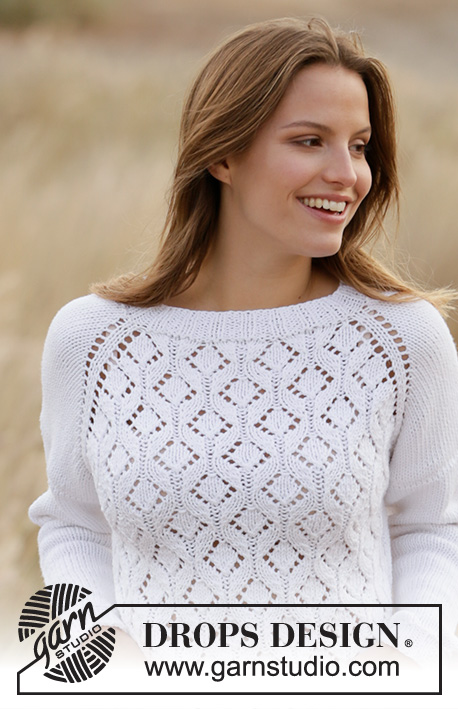 |
|||||||||||||||||||||||||||
Knitted jumper with raglan in DROPS Big Merino. Piece is knitted top down with lace pattern. Size: S - XXXL
DROPS 210-13 |
||||||||||||||||||||||||||||
|
---------------------------------------------------------- EXPLANATION FOR THE PATTERN: ---------------------------------------------------------- GARTER STITCH (worked in the round): 1 ridge = 2 rounds. Knit 1 round and purl 1 round. PATTERN: See diagrams A.1 to A.4. Diagrams show all rows in pattern seen from the right side. INCREASE TIP-1 (evenly): To calculate how to increase evenly, use the total number of stitches on row (e.g. 78 stitches) and divide stitches by number of increases to be done (e.g. 8) = 9.75. In this example increase by making 1 yarn over after approx. every 10th stitch. On next round knit yarn overs twisted to avoid holes. INCREASE TIP-2 (applies to sides of body): All increases are done from the right side. Work until 2 stitches remain before marker thread, 1 yarn over, knit 4 (marker thread is in the middle of these stitches), 1 yarn over. On next round knit yarn overs twisted to avoid holes. Then work the new stitches in stocking stitch. DECREASE TIP (applies to sleeves): Decrease 1 stitch on each side of marker thread as follows: Work until 3 stitches remain before marker thread and knit 2 together, knit 2 (marker thread is between these stitches), slip 1 stitch knitwise, knit 1, pass slipped stitch over stitch worked. ---------------------------------------------------------- START THE PIECE HERE: ---------------------------------------------------------- JUMPER - SHORT OVERVIEW OF THE PIECE: Neck edge, yoke and body are worked in the round on circular needle. Begin round in transition between left shoulder and back piece. Work sleeves in the round on double pointed needles/a short circular needle, top down. NECK EDGE: Cast on 80-80-80-88-88-88 stitches on circular needle size 4.5 mm with Big Merino. Knit 1 round, then work rib knit 2/purl 2. When piece measures 3 cm, work 1 ridge in GARTER STITCH over all stitches – read explanation above. Knit 1 round while increasing 6-6-6-18-18-18 stitches evenly - read INCREASE TIP-1 = 86-86-86-106-106-106 stitches. Switch to circular needle size 5 mm. YOKE: Work as follows: A.1 A (= 5 stitches), A.1 B over the next 20-20-20-30-30-30 stitches ( = 2-2-2-3-3-3 repetitions of 10 stitches), A.1 C (= 6 stitches), 2 stitches in stocking stitch (= raglan line), make 1 yarn over, 8 stitches in stocking stitch (= sleeve), make 1 yarn over, 2 stitches in stocking stitch (= raglan line), A.1 A, A.1 B over the next 20-20-20-30-30-30 stitches, A.1 C, 2 stitches in stocking stitch (= raglan line), make 1 yarn over, 8 stitches in stocking stitch (= sleeve), make 1 yarn over, 2 stitches in stocking stitch (= raglan line) = 8 stitches increased. There are now 94-94-94-114-114-114 stitches on needle. Continue pattern like this. On front and back piece increase in each side as shown in A.1, on sleeves increase with yarn overs on each side of stitches on sleeve (raglan line = always 2 stitches). Increase like this every other round. On next round knit the yarn overs to make holes. Work the increased stitches in stocking stitch on the sleeves. On front and back piece work the increased stitches in pattern as shown in A.1. REMEMBER THE KNITTING TENSION! When A.1 has been worked 1 time vertically, there are 166-166-166-186-186-186 stitches on needle. Continue pattern the same way upwards, i.e. pattern is repeated as shown in A.1. Every time 20 row have been vertically, there is room for 2 repetitions more of A.1B in width on back piece/front piece. When increase has been done 22-22-27-27-27-32 times in total on each side of A.1, there are 262-262-302-322-322-362 stitches on row, and piece measures approx. 24-24-28-28-28-33 cm from neck edge. Work next round as follows: Work 75-75-85-95-95-105 stitches as before (= back piece), slip the next 56-56-66-66-66-76 stitches on 1 stitch holder for sleeve, cast on 6-8-8-8-12-14 new stitches on needle (= in the side under sleeve), work the next 75-75-85-95-95-105 stitches as before (= front piece), slip the next 56-56-66-66-66-76 stitches on 1 stitch holder for sleeve, cast on 6-8-8-8-12-14 new stitches on needle (in the side under sleeve). Finish body and sleeves separately. NOW MEASURE THE PIECE FROM HERE! BODY: = 162-166-186-206-214-238 stitches. Insert 1 marker thread in each side, in the middle of the 6-8-8-8-12-14 stitches that were cast on under each sleeve. Move the marker threads upwards when working; they should be used for increase later. Work first round as follows, begin 3-4-4-4-6-7 stitches after marker thread (begin on round marked with arrow in each diagram): A.2 (= 7 stitches), work A.3 over the next 60-60-70-80-80-90 stitches (= 6-6-7-8-8-9 repetitions of 10 stitches), A.4 (= 8 stitches), work 6-8-8-8-12-14 stitches in stocking stitch (marker thread is in the middle of these 6-8-8-8-12-14 stitches), A.2 (= 7 stitches), work A.3 over the next 60-60-70-80-80-90 stitches (= 6-6-7-8-8-9 repetition of 10 stitches), A.4 (= 8 stitches), work 6-8-8-8-12-14 stitches in stocking stitch (marker thread is in the middle of these 6-8-8-8-12-14 stitches), Continue pattern like this, repeat A.2, A.3 and A.4 vertically. When piece measures 5 cm from division, increase 1 stitch on each side of both marker threads - read INCREASE TIP-2 = 4 stitches increased. Increase like this every 7 cm 4 times in total = 178-182-202-222-230-254 stitches. Work until piece measures approx. 29-31-29-31-33-31 cm from division. Switch to circular needle size 4.5 mm. Work 2 ridges. Switch back to circular needle size 5 mm. Cast off. Jumper measures approx. 58-60-62-64-66-68 cm from shoulder and down. SLEEVE: Slip the 56-56-66-66-66-76 stitches from stitch holder in one side of piece on a short circular needle/double pointed needles size 5 mm and pick in addition up 1 stitch in each of the 6-8-8-8-12-14 stitches cast on under sleeve = 62-64-74-74-78-90 stitches. Insert 1 marker thread in the middle of the 6-8-8-8-12-14 stitches under sleeve - move the marker thread upwards when working, it is used for decrease later. Begin round at the marker thread and work stocking stitch in the round. When piece measures 3 cm from division, decrease 2 stitches mid under sleeve - read DECREASE TIP. Decrease like this every 2½-2½-2-1½-1½-1 cm 12-12-16-16-17-22 times in total = 38-40-42-42-44-46 stitches. Continue until piece measures approx. 32-33-30-28-29-26 cm from division (shorter measurements in larger sizes because of longer yoke). Switch to double pointed needles size 4.5 mm. Knit 1 round while adjusting number of stitches to 40-40-44-44-44-48. Purl 1 round. Work rib in the round with knit 2/purl 2 for 4 cm. Cast off by knitting but make sure that the cast-off edge is not too tight. Sleeve measures approx. 36-37-34-32-33-30 cm from division. Work the other sleeve the same way. |
||||||||||||||||||||||||||||
Diagram explanations |
||||||||||||||||||||||||||||
|
||||||||||||||||||||||||||||

|
||||||||||||||||||||||||||||

|
||||||||||||||||||||||||||||

|
||||||||||||||||||||||||||||
|
Have you made this or any other of our designs? Tag your pictures in social media with #dropsdesign so we can see them! Do you need help with this pattern?You'll find tutorial videos, a Comments/Questions area and more by visiting the pattern on garnstudio.com. © 1982-2024 DROPS Design A/S. We reserve all rights. This document, including all its sub-sections, has copyrights. Read more about what you can do with our patterns at the bottom of each pattern on our site. |
||||||||||||||||||||||||||||
With over 40 years in knitting and crochet design, DROPS Design offers one of the most extensive collections of free patterns on the internet - translated to 17 languages. As of today we count 304 catalogues and 11422 patterns - 11422 of which are translated into English (UK/cm).
We work hard to bring you the best knitting and crochet have to offer, inspiration and advice as well as great quality yarns at incredible prices! Would you like to use our patterns for other than personal use? You can read what you are allowed to do in the Copyright text at the bottom of all our patterns. Happy crafting!










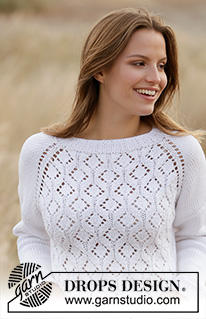
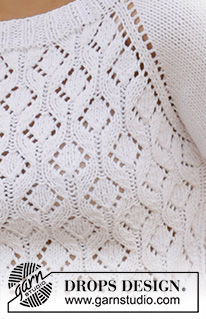


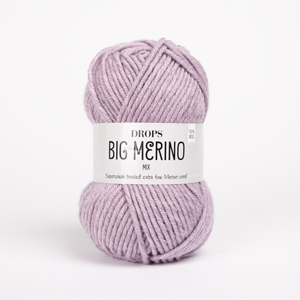
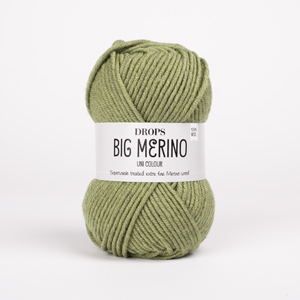
















































Comments / Questions (20)
Guten Tag, ich bin am Anfang des Pullovers und habe an der Halsblende gleichmäßig verteilt Maschen zugenommen. In der nächsten Runde muss ich u.a. zwei Maschen rechts zusammen stricken. Können Sie mir sagen wie man das macht, wenn eine der beiden Maschen nur ein Umschlag ist? Bei meinem bisherigen Versuch ist ein Loch entstanden, das da sicher nicht sein soll. Vielen Dank und viele Grüße Sabine
05.05.2023 - 15:47DROPS Design answered:
Liebe Sabine, so stricken Sie A.1A bei der 1. Runde: Umschlag, 1 M rechts, Umschlag, 2 M rechts, 1 M abheben, 1 M rechts, die abgehobene Masche über die gestrickte Masche ziehen; A.1B: 1 M links, 2 M re zs, 2 M re, Umschlag, 1 M re, Umschlag, 2 M re, 1 M abheben, 1 M rechts, die abgehobene Masche über die gestrickte Masche ziehen, A.1C: 1 M li, 2 M re zs, 2 M re, Umschlag, 1 M re, Umschlag. Bei der nächsten Runde stricken Sie alle Umschläge rechts, es sollen Löcher entstehen. Viel Spaß beim stricken!
05.05.2023 - 17:06Bonjour, j ai deux questions : la première on augmente bien de 8mailles (4 par manches) tous les 2 rangs ? La deuxième est sur le fait de faire 2 fois A1b après on doit faire A1a et a1c 1 fois du coup ?
19.09.2022 - 12:29DROPS Design answered:
Bonjour Melanie, on augmente 8 mailles par tour: 1 maille de chaque côté des 2 mailles du raglan tricotées en jersey à la transition du dos/devant et des manches. Quand on a tricoté 20 rangs (et augmenté comme dans les diagrammes A et C), on a augmenté 10 mailles dans A et dans C = soit 1 motif de B en plus de chaque côté; tricotez A.1A au-dessus des 5 premières m de A.1A précédent et les 10 m suivantes en B, puis les 10 premières m du C précédent en B et les 6 dernières mailles en C. Bon tricot!
20.09.2022 - 09:37Siempre me respondieron las consultas, no se que pasa que con esta no tengo novedades. Me gustaría poder avanzar con el tejido, sigo esperando la respuesta a mi pregunta. Gracias!!!
22.07.2022 - 01:24Hola! Estoy tejiendo este patrón en talla XL. La indicación dice que al terminar 20 vueltas de A1 debería tener 186 puntos, pero sumando los aumentos de las mangas yo tengo 230 puntos. Los aumentos de las mangas van en todas las vueltas? Por otro lado, no me queda claro como comenzar la segunda repetición, ya que en lo que sería A1.A y A1. C ahora hay más puntos, no se como distribuírlos.
21.07.2022 - 01:21DROPS Design answered:
Hola Diana, A.1A y A.1C se trabajan siempre en los extremos. Después de cada 20 filas trabajas 2 repeticiones más de A.1B entre A.1A y A.1C. Los aumentos para el cuerpo están en A.1A y A.1C. Los aumentos de la manga son aparte y se trabajan cada 2ª fila. Después de la 1ª fila con aumentos tienes 114 pts. En la siguiente fila no aumentas. En cada fila con aumentos (que es cada 2ª fila, es decir, una sí y en la siguiente no) aumentas 8 pts. En las 18 filas de A.1 restantes, aumentas 8 pts en cada fila y aumentas en filas alternas/ cada 2ª fila, así que has aumentado 72 pts más. En total, deberías tener 186 pts, incluyendo todo tipo de aumentos.
24.07.2022 - 19:13Buenos días! Estoy tejiendo este patrón en talla XL. La indicación dice que al terminar 20 vueltas de A1 debería tener 186 puntos, pero sumando los aumentos de las mangas yo tengo 230 puntos. Por otro lado, no me queda claro como comenzar la segunda repetición, ya que en lo que sería A1.A y A1. C ahora hay más puntos, no se como distribuírlos.
20.07.2022 - 15:28DROPS Design answered:
Hola Diana, puedes ver la respuesta arriba.
24.07.2022 - 19:14Hallo! Nach welchen Schema wird das Vorder bzw. Rückenteil gestrickt? Bitte um Rückmeldung. Danke! Lg Andrea Rademacher
08.11.2021 - 17:20DROPS Design answered:
Liebe Frau Rademacher, meinen Sie Rumpfteil nach der Verteilung am Ende der Passe? Die werden mit A.2, A.3 und A.4 gestrickt mit jeweils glatt rechte Maschen an den Seiten. Viel Spaß beim stricken!
09.11.2021 - 12:47Dzień dobry, mam problem z liczbą oczek dla rozmiaru M w Karczku - po zsumowaniu wszystkich oczek wychodzi mi 90 - a w opisie podano 94 oczka. Dodatkowo napisano, że "dodano 8 oczek", a przecież są tylko 4 narzuty. Proszę o pomoc w zrozumieniu tego opisu..
08.11.2021 - 07:36DROPS Design answered:
Witaj Alicjo, przed rozpoczęciem karczku w rozmiarze M masz 86 oczek. W 1-szym okrążeniu karczku wykonujesz 4 narzuty i dodatkowo będziesz miała 4 dodane oczka w schematach A.1A i A.1C. W sumie po przerobieniu 1-szego okrążenia karczku jest 94 oczka. Powodzenia i miłej pracy!
08.11.2021 - 07:57Bonjour Madame, Je vous serais reconnaissante de bien vouloir m'indiquer si je peux réaliser ce modèle avec Drops belle uni colour, ayant fait une erreur inexplicable lors de ma commande ; cela m'éviterait de retourner mes pelotes. Je vous remercie. Cordialement. Mme Marcheron
04.08.2021 - 22:48DROPS Design answered:
Bonjour Mme Marcheron, ce pull se tricote en DROPS Big Merino, qui appartient au groupe C de nos fils alors que Belle appartient au groupe B et ne peut donc pas être utilisé ici, l'échantillon serait différent, vous trouverez ici tous les modèles de pulls femme en laine/fil du groupe B où vous pourrez utiliser Belle, vous trouverez peut-être un autre modèle qui vous conviendra? Utilisez le convertisseur pour obtenir la quantité nécessaire en Belle si besoin. Bon tricot!
05.08.2021 - 09:06Bonjour Madame, Dans empiècement, tricoter A.1A =5mailles, A.1B au dessus des 20 mailles suivantes. Au dessus ? Je ne comprends pas comment faire au dessus. Je vous remercie d'avance de me renseigner avant que j'effectue ma commande Cordialement Martine
13.05.2021 - 14:25DROPS Design answered:
Bonjour Mme Marcheron. cela veut dire que vous devez tricoter 20 mailles suivantes ainsi: 2 x diagramme A.1B (1 rapport compte 10 mailles). Bon tricot!
13.05.2021 - 15:41Hi, I am half-way through knitting this jumper (I am enjoying it very much!), but it's for a present so needs to be finished soon. Unfortunately, your site is having some technical problems displaying the images. Is there any way you can send me a pdf version? Many thanks
16.03.2021 - 11:34DROPS Design answered:
Dear Tamara, unfortunately we cannot send out these PDF's so, please be patient. We are working hard to restore the pictures as soon as we can. Thank you for your understanding and patience.
16.03.2021 - 12:45